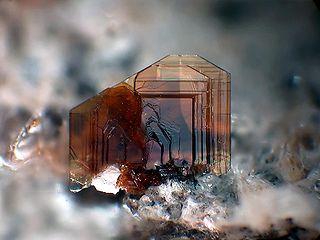
Biotite is a common group of phyllosilicate minerals within the mica group, with the approximate chemical formula K(Mg,Fe)3AlSi3O10(F,OH)2. It is primarily a solid-solution series between the iron-endmember annite, and the magnesium-endmember phlogopite; more aluminous end-members include siderophyllite and eastonite. Biotite was regarded as a mineral species by the International Mineralogical Association until 1998, when its status was changed to a mineral group. The term biotite is still used to describe unanalysed dark micas in the field. Biotite was named by J.F.L. Hausmann in 1847 in honor of the French physicist Jean-Baptiste Biot, who performed early research into the many optical properties of mica.

In geology and mineralogy, a mineral or mineral species is, broadly speaking, a solid substance with a fairly well-defined chemical composition and a specific crystal structure that occurs naturally in pure form.
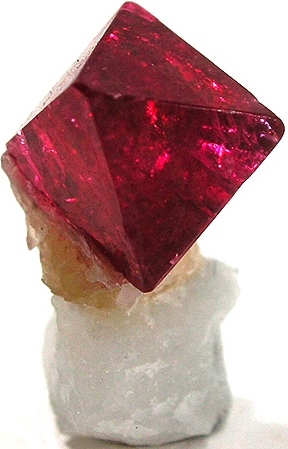
Spinel is the magnesium/aluminium member of the larger spinel group of minerals. It has the formula MgAl
2O
4 in the cubic crystal system. Its name comes from the Latin word spinella, a diminutive form of spine, in reference to its pointed crystals.
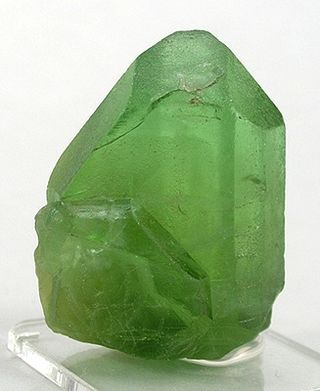
The mineral olivine is a magnesium iron silicate with the chemical formula (Mg,Fe)2SiO4. It is a type of nesosilicate or orthosilicate. The primary component of the Earth's upper mantle, it is a common mineral in Earth's subsurface, but weathers quickly on the surface. Olivine has many uses, such as the gemstone peridot, as well as industrial applications like metalworking processes.

The pyroxenes are a group of important rock-forming inosilicate minerals found in many igneous and metamorphic rocks. Pyroxenes have the general formula XY(Si,Al)2O6, where X represents calcium (Ca), sodium (Na), iron or magnesium (Mg) and more rarely zinc, manganese or lithium, and Y represents ions of smaller size, such as chromium (Cr), aluminium (Al), magnesium (Mg), cobalt (Co), manganese (Mn), scandium (Sc), titanium (Ti), vanadium (V) or even iron. Although aluminium substitutes extensively for silicon in silicates such as feldspars and amphiboles, the substitution occurs only to a limited extent in most pyroxenes. They share a common structure consisting of single chains of silica tetrahedra. Pyroxenes that crystallize in the monoclinic system are known as clinopyroxenes and those that crystallize in the orthorhombic system are known as orthopyroxenes.

Wüstite is a mineral form of mostly iron(II) oxide found with meteorites and native iron. It has a grey colour with a greenish tint in reflected light. Wüstite crystallizes in the isometric-hexoctahedral crystal system in opaque to translucent metallic grains. It has a Mohs hardness of 5 to 5.5 and a specific gravity of 5.88. Wüstite is a typical example of a non-stoichiometric compound.
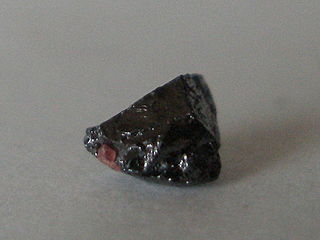
Armalcolite is a titanium-rich mineral with the chemical formula (Mg,Fe2+)Ti2O5. It was first found at Tranquility Base on the Moon in 1969 during the Apollo 11 mission, and is named for Armstrong, Aldrin and Collins, the three Apollo 11 astronauts. Together with tranquillityite and pyroxferroite, it is one of three new minerals that were discovered on the Moon. Armalcolite was later identified at various locations on Earth and has been synthesized in the laboratory. (Tranquillityite and pyroxferroite were also later found at various locations on Earth). The synthesis requires low pressures, high temperatures and rapid quenching from about 1,000 °C to the ambient temperature. Armalcolite breaks down to a mixture of magnesium-rich ilmenite and rutile at temperatures below 1,000 °C, but the conversion slows down with cooling. Because of this quenching requirement, armalcolite is relatively rare and is usually found in association with ilmenite and rutile, among other minerals.

Forsterite (Mg2SiO4; commonly abbreviated as Fo; also known as white olivine) is the magnesium-rich end-member of the olivine solid solution series. It is isomorphous with the iron-rich end-member, fayalite. Forsterite crystallizes in the orthorhombic system (space group Pbnm) with cell parameters a 4.75 Å (0.475 nm), b 10.20 Å (1.020 nm) and c 5.98 Å (0.598 nm).
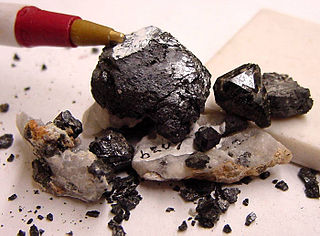
Hercynite is a spinel mineral with the formula FeAl2O4.
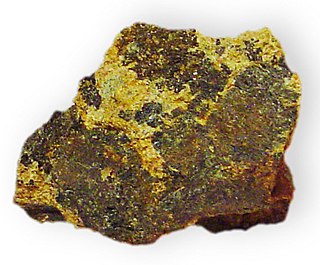
Cummingtonite is a metamorphic amphibole with the chemical composition (Mg,Fe2+
)
2(Mg,Fe2+
)
5Si
8O
22(OH)
2, magnesium iron silicate hydroxide.
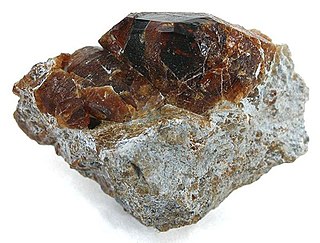
Chondrodite is a nesosilicate mineral with formula (Mg,Fe)
5(SiO
4)
2(F,OH,O)
2. Although it is a fairly rare mineral, it is the most frequently encountered member of the humite group of minerals. It is formed in hydrothermal deposits from locally metamorphosed dolomite. It is also found associated with skarn and serpentinite. It was discovered in 1817 at Pargas in Finland, and named from the Greek for "granule", which is a common habit for this mineral.
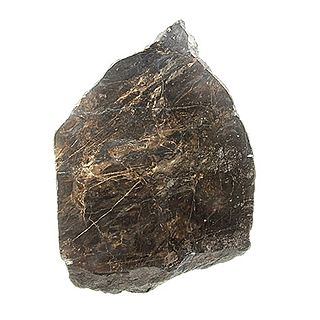
Galaxite, also known as 'mangan-spinel' is an isometric mineral belonging to the spinel group of oxides with the ideal chemical formula Mn2+Al2O4.
In inorganic chemistry, mineral hydration is a reaction which adds water to the crystal structure of a mineral, usually creating a new mineral, commonly called a hydrate.

Wadsleyite is an orthorhombic mineral with the formula β-(Mg,Fe)2SiO4. It was first found in nature in the Peace River meteorite from Alberta, Canada. It is formed by a phase transformation from olivine (α-(Mg,Fe)2SiO4) under increasing pressure and eventually transforms into spinel-structured ringwoodite (γ-(Mg,Fe)2SiO4) as pressure increases further. The structure can take up a limited amount of other bivalent cations instead of magnesium, but contrary to the α and γ structures, a β structure with the sum formula Fe2SiO4 is not thermodynamically stable. Its cell parameters are approximately a = 5.7 Å, b = 11.71 Å and c = 8.24 Å.

Gedrite is a crystal belonging to the orthorhombic ferromagnesian subgroup of the amphibole supergroup of the double chain inosilicate minerals with the ideal chemical formula Mg2(Mg3Al2)(Si6Al2)O22(OH)2.

Dollaseite-(Ce) is a sorosilicate end-member epidote rare-earth mineral which was discovered by Per Geijer (1927) in the Ostanmossa mine, Norberg district, Sweden. Dollaseite-(Ce), although not very well known, is part of a broad epidote group of minerals which are primarily silicates, the most abundant type of minerals on earth. Dollaseite-(Ce) forms as dark-brown subhedral crystals primarily in Swedish mines. With the ideal chemical formula, CaREE3+
Mg
2AlSi
3O
11,(OH)F, dollaseite-(Ce) can be partially identified by its content of the rare earth element cerium.

Zemannite is a very rare oxide mineral with the chemical formula Mg0.5ZnFe3+[TeO3]3·4.5H2O. It crystallizes in the hexagonal crystal system and forms small prismatic brown crystals. Because of the rarity and small crystal size, zemannite has no applications and serves as a collector's item.
The spinels are any of a class of minerals of general formulation AB
2X
4 which crystallise in the cubic (isometric) crystal system, with the X anions arranged in a cubic close-packed lattice and the cations A and B occupying some or all of the octahedral and tetrahedral sites in the lattice. Although the charges of A and B in the prototypical spinel structure are +2 and +3, respectively, other combinations incorporating divalent, trivalent, or tetravalent cations, including magnesium, zinc, iron, manganese, aluminium, chromium, titanium, and silicon, are also possible. The anion is normally oxygen; when other chalcogenides constitute the anion sublattice the structure is referred to as a thiospinel.

Hidalgoite, PbAl3(AsO4)(SO4)(OH)4, is a rare member of the beudantite group and is usually classified as part of the alunite family. It was named after the place where it was first discovered, the Zimapán mining district, Hidalgo, Mexico. At Hidalgo where it was initially discovered, it was found as dense white masses in alternating dikes of quartz latite and quartz monzonite alongside other secondary minerals such as sphalerite, arsenopyrite, cerussite and trace amounts of angelsite and alamosite, it was then rediscovered at other locations such as Australia where it occurs on oxidized shear zones above greywacke shales especially on the anticline prospects of the area, and on fine grained quartz-spessartine rocks in Broken Hill, Australia. Hidalgoite specimens are usually associated with copper minerals, clay minerals, iron oxides and polymetallic sulfides in occurrence.
Filipstadite is a very rare mineral of the spinel group, with the formula (Mn,Mg)(Sb5+0.5Fe3+0.5)O4. It is isometric, although it was previously thought to be orthorhombic. When compared to a typical spinel, both the octahedral and tetrahedral sites are split due to cation ordering. Filipstadite is chemically close to melanostibite. The mineral comes from Långban, Sweden, a manganese skarn deposit famous for many rare minerals.

















